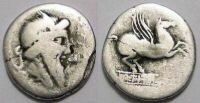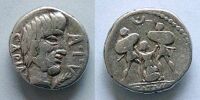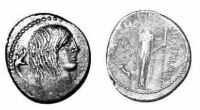




Roman Women on Coins





| Mutinus Titinus |

|
Issuer: | Q. Titius, c. 90 B.C. AR Denarius. |
| Obverse: | Head of Priapus (Mutinus Titinus) right. | |
| Reverse: | Q TITI on base. Pegasus springing right. | |
| Grade: | F. 3. 1 g, 17mm. | |
| Details | Reference: | Sear 713 |
|
Comments: This piece was minted circa 90 BC, under the authority of the moneyer Q. Titius. The obverse type depicts the head of Mutinus Titinus right, bound with winged diadem. The reverse type features Pegasus springing right from a tablet inscribed Q.TITI. The god Mutinus Titinus is the same as Priapus, who had a temple at Rome, and who was especially worshipped by young married women. | ||
| Rape of Sabine Women |

|
Issuer: | L.Titurius L. f. Sabinus, 89 BC. AR Denarius. |
| Obverse: | SABIN. Bare head of Sabine king Tatius facing right. | |
| Reverse: | L. TITVRI in the exergue. Two Roman soldiers, each bearing a woman in his arms. | |
| Grade: | F | |
| Details | Reference: | Sear 249, CRR 698 |
|
Comments: Moneyer's gens traced its descent from the Sabines, and perhaps from the legendary King of the Sabine town of Cures Titus Tatius himself, which accounts for the use of the head of Tatius on all of the types of moneyer. In 89 B.C., the year this coin is thought to have been struck, the leader Sulla was gaining victories in Southern Italy in the Italian wars. The reverse type is a reference to the rape of the Sabines by the Romans. Coin is struck on a smallish flan, but otherwise grades F, with clear devices and all legends readable. A very decent example of the type, catalouged as Tituria 2. | ||
| Tarpeia |

|
Issuer: | L.Titurius L. f. Sabinus, 89 BC. AR Denarius. |
| Obverse: | SABIN. Bare head of Sabine king Tatius facing right, palm branch before. | |
| Reverse: | L. TITVRI in the exergue. Tarpeia facing, buried to her waist in shields, trying to ward off two sabine soldiers who are about to cast their shields on her, star within crescent moon above. | |
| Grade: | aVF | |
| Details | Reference: | Sear 251 |
|
Comments: In a subplot of the myth of the rape of the Sabine women, Tarpeia was a Vestal Virgin that betrayed the city of Rome to the Sabines when they were attempting to rescue their daughters. The price for her betrayal was what the Sabine soldiers wore on their left arms, meaning their gold bracelets. The Sabines were offended by Tarpeia's greed and treason, and took her price literally. She met her death under the crushing weight of the soldiers' shields. Nice example of the type, catalouged as Tituria 4. | ||
| Janus |

|
Issuer: | Lucius Titurius L. f. Sabinus, cca 89 BC. As, bronze. |
| Obverse: | Bearded head of Janus. | |
| Reverse: | L.TITURI/SABINUS above and below vessel's prow to the right. Small victory flying before. | |
| Grade: | VF. 10.2 g, 27.93 mm. Dark green patina. Well centered, high relief obverse. | |
| Details | Reference: | Sear 745, Babelon 7 |
|
Comments: Janus is unique Italic god that appeared in no other mythology except Roman. Janus was the god of gates, doors, beginnings, endings and doorways. The month of January was named for him. His had two faces, (originally, one was always bearded, one clean-shaven; later both bearded) that originally represented the sun and the moon. Janus was worshipped at the beginnings of the harvest and planting times, as well as marriages, births and other beginning. He was representative of the middle ground between barbarity and civilization, rural country and urban cities and youth and adulthood. He supposedly came from Thessaly in Greece and shared a kingdom with Camese in Latium. They had many children, including Tiberinus, a genius who lived in the Roman river Tiber. According to the legend, Tiberinus helped Aeneas in his travel from Troy, suggested him to land in Latium and gave him much other precious advice. As the sole ruler of Latium, Janus heralded the Golden Age, introducing money, laws and agriculture (making him a culture hero). When Romulus and his men stole the women of the Sabines, and Sabines attacked Rome in revenge, they were shown the way to citadelle by bribed Tarpeia. But, Janus whose functions were also to open channel for fountains, maked a hot spring to erupt, causing the would-be attackers to flee. In honor of this, on this spot a temple of Janus was erected. The doors to his temples were kept open during war so that he could easily intervene. The doors and gates were closed during peace. This connection with Sabine war was the probably the reason why moneyer Lucius Titurius Sabinus included Janus on one of his coin issues. A very difficult coin to find clear and legible. | ||
| Juno Sospita |

|
Issuer: | L. Roscius Fabatus, 59 BC. Serratus Denarius (3.87 gm.; 18 mm.) |
| Obverse: | Head of Juno Sospita wearing goat-skin cap, modius symbol behind, L ROSCI beneath. | |
| Reverse: | Virgin girl in long clothe standing right feeding serpent before which erects before her in several coils, symbol to left, behind cista, FAB in exergue. | |
| Grade: | aVF | |
| Details | Reference: | Crawford 412/1; Syd 915; Roscia 3; Albert 1329. Scarce |
|
Comments: The worship of Juno Sospita was introduced into Rome from Lanuvium. She was the protecting genius of women, accompanying them through life from birth to death. Thr symbol on the obverse and reverse are related and there are at least 235 pairs. They are well executed and cover the whole range of Roman life and industry, etc., and are of great interest to the antiquarian. They are mostly symbolic of the various trade-guilds. She is armed with a buckler and lance to defend the people under her protection. The serpent which is at her feet is a symbol of the health and safety which they owe to her, and also serves to typify the serpent to which a young girl of Lanuvium went every year to offer it nourishment in its cavern. Juno Sospita was an aspect of the goddess Juno as the protector of Rome. There was a temple to Juno Sospita in the Forum Holitorium that was dedicated in 194 B.C. Juno Sospita Mater Regina (Juno Savior, Mother, Queen) was a fertility and protection goddess whose festival was on the first of February. Every year, on the first of March, women held a festival in honor of Juno called the Matronalia. On this day, lambs and other cattle were sacrificed in her honor. Another festival called the Nonae Caprotinae ("The Nones of the Wild Fig") was held on July 7. Many people consider the month of June, which is named after the goddess who is the patroness of marriage, to be the most favorable time to marry. Lucina was an epithet for Juno as "she who brings children into light." Juno's own warlike aspect among the Romans is apparent in her attire. She often appeared armed and wearing a goatskin cloak, which was the garment favoured by Roman soldiers on campaign. This warlike aspect was assimilated from the Greek goddess Athena, whose goatskin was called the 'aegis'. | ||
| Gallia |

|
Issuer: | Lucius Hostillus Saserna, 48 BC. AR Denarius. |
| Obverse: | Head of female Gallic captive right with dishevelled hair, carnyx behind. | |
| Reverse: | L. HOSTILVS SASERNA. Cultus statue of Diana /Artemis) facing with stag and spear. | |
| Grade: | aVF | |
| Details | Reference: | Sear 1402, CRI 55, Sydenham 1013, RRC 458/1, S 1402. |
|
Comments: The woman depicted on this coin face on this coin is said to be a real woman. She has often been called Gallia, a concept that would be absolutely foreign to the tribal Celts. More likely she represents a captive. Hear hair is long in a non-Roman fashion and almost modern in appearance, perhaps limed and forming dreadlocks. Her face is pretty in contrast to most Roman females depicted on coins. Perhaps, she was indeed picked for this coin because her beauty. It has been suggested that the reverse of this coin, which depicts Artemis in a Greek fashion, commemorates Caesar's taking of Massilia which interfered with his march to Spain. Massila was an ancient Greek city and Artemis dear to her. | ||
| Julius Caesar - Aeneus |

|
Issuer: | Unknown. North Africa (Carthage?), 47-46 BC. AR Denarius. |
| Obverse: | No legend, diademed head of Venus right. | |
| Reverse: | CAESAR. Aeneas walking left, head facing, holdins Palladium and bearing his father Anchises on left shoulder. | |
| Grade: | F. 3.0 g | |
| Details | Reference: | Sear 1402, CRI 55, Sydenham 1013, RRC 458/1, S 1402. |
|
Comments: Caesar claimed his descendence from goddess Venus, therefore from Aeneas as well. Aeneas is, himself, ancestor of Rhea Silvia, the mother of Romulus and Rhemus, co'founders of Rome. An unprecedented example of antic propaganda! | ||
| Octavian Augustus - Tarpeia |

|
Issuer: | P. Petronius Turpilianus, moneyor, 19 BC. AR Denarius. |
| Obverse: | CAESAR AVGVSTVS. His bare head right. | |
| Reverse: | TVRPILIANVS III VIR. Tarpeia facing, her arms uplifted, buried to her waist in shields. | |
| Grade: | aVF, with a banker's mark on the obverse. | |
| Details | Reference: | Sear 1639, RIC 299. |
|
Comments: The extant historical sources agree that the story of Tarpeia involves deceit and betrayal. In one version of the myth on war with Sabines, (which was generally not selected by other historical writers) poets Propertius and Ovid adapted the Tarpeia tale to poetry in such way that miraculous behaviour of water benefits Rome. The resulting synthesis of the Tarpeia myth with and account of Janus saving Rome with a flood, shows that the poets were aware of a pattern in myths of early Rome in which the divinely controlled presence or absence of water protects the city (e.g. the Tiber does not drown Romulus and Remus; Vertumnus and Janus regulate the flow of water in the Forum). The Augustan period itself may have had something to do with the focus on water in our poetic sources. Namely, Augustus' building program involved a number of hydrological improvements, including expansion of the system of aqueducts and repairs to the Cloaca Maxima. Augustus, who saw himself as Rome's second founder, was careful to balance innovation with restoration, perhaps in part because Rome's mythical tradition indicates that while divine influence over water brings success, human attempts at control generally fail. As the Augustus' hydrological improvements connect him with the Tarpea episode, this was probably the reason why she was depicted on this particular coin. However, the inspiration for this type was provided by the coinage of the moneyer L. Titurius Sabinus issued seven decades before. | ||
| Fulvia, 1st wife of Mark Anthony |

|
Issuer: | Fulvia silver denarius |
| Obverse: | Winged head of Fulvia as the gooddess Victory , with drapped bust | |
| Reverse: | L MUSSIDIVS LONGVS, Victory in galloping biga right. | |
| Grade: | VF | |
| Details | Reference: | RRC 494/40 CRI 186 BMCRR 4229 RSC Mussidia 4 |
|
Comments: Daughter of Marcus Fulvius Bambalio and Sempronia, both from diminishing ancient families, but still of the upper class, freeborn, and Roman citizens. Nothing known of her early life. she was married to three senators, and "possessed a spirit and strength of character unmatched by any of her three husbands." (1) Publius Clodius (Pulcher) - an orator/politician and demagogue (murdered in 52 BCE by his rival Milo) (2) Curio - another outstanding orator (died fighting in Africa under Caesar in 49 BCE) (3) Marc Antony (married sometime between 47-44; a rocky yet passionate, politically contrived marriage) | ||
| Octavia, 4th wife of Mark Anthony |

|
Issuer: | Octavia & Marc Antony, AR quinarius, Gaul, 39 BC |
| Obverse: | R. P. C. III. VIR. Diademed veiled head right of Concordia representing Octavia. | |
| Reverse: | M ANTON CAESAR. Clasped hands holding caduceus. | |
| Grade: | Good VF, a bit off center, as usual with this issue. 1.64g | |
| Details | Reference: | Sear 1575, C 529/4, Vagi 200. |
|
Comments: Octavia (b. AD 22 d. 48) was the sister of Octavian (later Augustus) and became the fourth wife of the Roman triumvir Mark Anthony. Vagi argues convincingly that the portrait of Concordia on this coin has the facial features of Octavia, and the ostensible link between them at this time. ". . . The quinarius was presumably struck by Octavian in Gaul shortly after Octavian and Antony had reconciled at Brundisium in October, 40 BC. In addition to signing a peace treaty, Antony also married Octavia as a gesture of cooperation. Though in a general sense this quinarius trumpets the "concord" these two men now theoretically enjoyed, the head of Concordia might specifically represent Octavia (as [others] seem to represent Fulvia) in her new mediating role as wife of Antony and sister of Octavian." | ||
| Livia - Tribute Penny |

|
Issuer: | Tiberius and Livia, Tribute Penny of the Bible 15-26 AD |
| Obverse: | TI CAESAR DIVI AVG F AVGVSTVS REV. Laureate bust of Tiberius to right | |
| Reverse: | PONTIF MAXIM. Female figure (Livia?) sits on a plain chair right, holding olive branch in her left hand and long sceptre in her right hand. | |
| Grade: | Good VF. 3.6 g, 17 mm | |
| Details | Reference: | RIC 26 |
|
Comments: This coin is often referred to as the "Tribute Penny" as this coin was the most abundant type circulating in Israel during the time of Jesus. Tiberius reigned during the ministry of Jesus and it is most probable that his silver denarius was the coin used by Jesus when he had been asked about the tribute money. "Is it lawful to give tribute to Caesar, or not? Shall we give, or shall we not give? but He, knowing their hypocrisy, said unto them, Why do you tempt me? Bring me a penny, that I may see it. And they brought it. And He said to them, Whose image is this? And they said to Him, Caesar's. And Jesus, answering, said to them, Render unto Caesar the things that are Caesar's and to God the things that are God's." The tribute penny shows emperor Tiberius, who ruled Rome from A.D. 14 to 37, on the front and the legend "Tiberius Caesar Augustus, Son of the Divine Augustus." The back shows his mother, Livia, seated and the words "High Priest," one of Tiberius' many titles. | ||
| Poppaea |

|
Issuer: | Nero and Popaea, billon tetradrachm. Struck at Alexandria, Egypt. |
| Obverse: | Radiate head of Nero to right. | |
| Reverse: | Head of Poppaea to right. | |
| Grade: | VF. 26.1 mm, 6.99 g. The coin is a bit light because it was found in a sea hoard and some of the bronze leached out of it. | |
| Details | Reference: | Sear 713 |
|
Comments: Sabina Poppaea was the second wife of Emperor Nero. She was the daughter of Titus Ollius and granddaughter of the famed proconsul Poppaeus Sabinus. Poppaea was a woman of striking beauty whose charms and grace were hid from sight by her licentious nature, ambition and an inability to love anyone, according to Tacitus. Poppaea's first husband was the Prefect of the Praetorian Guard - Rufrius Crispinus. Although she bore him a son, she became adulterously involved with Marcus Otho, who would one day briefly reign as Emperor in the coming Civil War. Poppaea left Crispinus, married Otho and soon attracted Nero in 58 AD. Otho's position as a friend was sacrificed in favor of Poppaea's role as mistress. As Empress, Poppaea was ruthless. During the summer of 65 AD, Poppaea was kicked in the stomach by Nero while she was pregnant. She did not survive and died from internal injuries. Nero's murder of Poppaea appears to have taken place during a fit of rage and was not premeditated. Nero was later quite distressed and missed her greatly. She was deified and embalmed rather than cremated, which was certainly against Roman custom, perhaps since he could not burn someone who had been so beautiful. | ||

 [ www.franic.info]
This document validates as
[ www.franic.info]
This document validates as